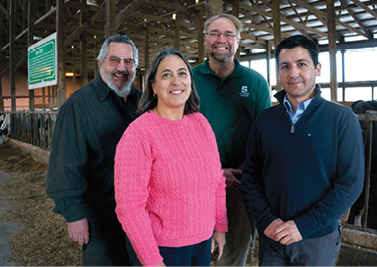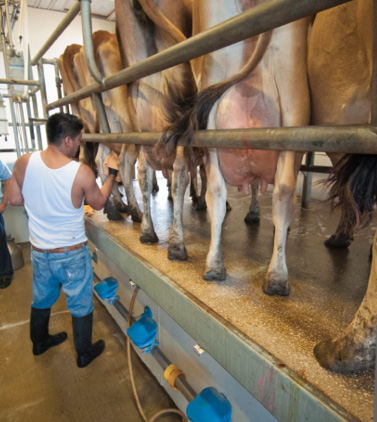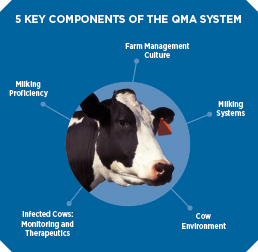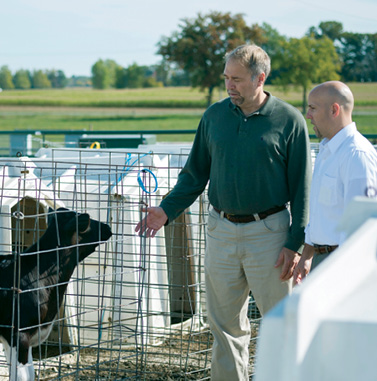The Quality Milk Alliance

MSU Quality Milk Alliance members Rubén Martinez, Lorraine Sordillo, Ron Erskine, and Andrés Contreras at the MSU Dairy Farm.
MSU's College of Veterinary Medicine and the Julian Samora Research Institute (JSRI) are collaborating with partners from Florida Agricultural and Mechanical University, Pennsylvania State University, and Syracuse University, as well as veterinarians, producers, and other dairy professionals, on a project to reduce mastitis and antibiotic use on dairy farms. Mastitis, an infection of a cow's udder, is a persistent, endemic problem on dairy farms, leading to economic losses, reduced milk quality, and decreased longevity and well-being of the cow. While producers have been following protocols for preventing and treating mastitis for years, changing demographics in the industry are bringing new challenges to managing the disease.
Ron Erskine, professor in the College of Veterinary Medicine, is the primary investigator leading a $3 million, U.S. Department of Agriculture-funded project to develop a multidisciplinary approach for reducing occurrences of mastitis while addressing these new challenges. "The overarching goal is to improve the quality and supply of dairy foods here in the U.S.," said Erskine. "To that end, our project is involved in helping dairy producers and their employees, and people who work with them, like veterinarians, target mastitis…And because mastitis is one of the most common reasons antibiotics are used on dairy farms, a second goal is to reduce the use of antibiotics."
The team of partners who collectively make up the Quality Milk Alliance (QMA) started working on this project in 2013 with the goal of reducing antibiotic use among dairy cows by half and mastitis by a third within five years.
In the first year of the project, the team met with focus groups and conducted a survey of dairy farms in Michigan, Pennsylvania, and Florida to gather data on current mastitis treatment practices. Using the data, Erskine's team was able to see that while farms were doing well at implementing mastitis protocols, there was still room for improvement in several areas, including management and training of employees. This is due, in large part, to a transition in the dairy industry from small, family-owned farms to larger farms with a diverse work force, including many Spanish-speaking employees.
Impact of Workplace Culture on Employee Performance
Rubén Martinez, professor of sociology in the College of Social Science and director of the Julian Samora Research Institute, is leading an evaluation team of social scientists who are looking at this project from a social science perspective, focusing on organizational, behavioral, and management aspects, especially in light of the changing cultural demographics. "The social side of agriculture is what we understand," said Martinez. "Dairy farms are businesses, so they have the same organizational dimensions as other firms, except that as an industry, it's going through a couple of major transitions."
According to Martinez, many factors are increasingly affecting the performance of employees, such as morale, ability to acquire basic skills, and workplace environment. "We didn't necessarily know when we wrote the proposal that labor and management would become one of the critical elements," said Martinez, "not just for addressing mastitis, but for providing a workplace environment that is conducive to good employee morale and good compliance with protocols."

Project co-investigator Jean Kayitsinga, also of JSRI, agreed. "Using survey results collected from 628 dairy farms in Michigan, Pennsylvania, and Florida, we found that proven management practices such as the use of internal teat sealant, blanket dry cow therapy, and not using water during udder preparation before milking were associated with lower bulk tank somatic cell count (BTSCC)," he said. "In addition, we found that dairy farmer and manager beliefs and attitudes, including the perception of mastitis problems and the threshold of concern if BTSCC is above 300,000 cells/mL, were associated with higher BTSCC. Finally, employee management strategies (e.g., ensuring compliance with milking protocols and giving employees a financial or other penalty if BTSCC increased) and a perceived importance of reducing labor costs were associated with lower BTSCC in farms with nonfamily employees"1
One issue is that many employees are not from a farm background and therefore lack knowledge of protocols. "One of the things that came through in the focus groups is that workers expressed an interest in knowing more about why they're doing what they're doing," said Martinez. "In other words, what is somatic cell count, what are the factors contributing to mastitis—all these kinds of things."
A Student's Perspective
One of the members of Martinez's team is Joanna Acosta, a senior in MSU's Animal Science program. She analyzes the data from the focus groups to discover major themes, such as employee training, language barriers, and discrimination on the farm. "Through the focus groups that we've conducted we actually learned that discrimination does have a very big impact on farm profitability, because if the employees feel undervalued and if they're not having good communication with their peers, then that hinders the progress of the farm."
Growing up, she always wanted to be a veterinarian, and now that she's about to graduate and apply to veterinary school at MSU, she's happy to be having this experience. "I think it's very exciting that we are one of the few studies that is taking a look at the Hispanic employees," said Acosta. "We're bringing up the topics that concern them; so by doing that, we're creating awareness, and we are also going for a solution and trying to fix it."
Evaluation and Implementation

Components of the QMA evaluation system, including farm management culture.
Using data from the surveys and focus groups, the QMA team developed an evaluation system to help producers and herd veterinarians assess current control practices, such as how the cows are milked, the equipment used for milking, the environment the cows live in, and how farmers use drugs and monitor mastitis, as well as a fifth element uniquely important to this study—the management culture. "If you're going to address the incidence of mastitis," said Martinez, "then, along with the science and medical research, the labor force becomes the primary factor in the practices that occur on the dairy farms to reduce the incidence and to treat and maintain the conditions in which the minimum prevalence of mastitis occurs."
After an initial pilot study last year, the quality milk evaluation system was refined and will be implemented on approximately 130 farms in three states for 12 months. Under the leadership of partners from Penn State, the team is also creating an education program in which students and veterinarians can complete online and hands-on components to become certified Quality Milk Alliance (QMA) specialists who will be able to use the evaluation systems on the farms and make necessary reforms. "At the end of the project, we hope that we will have developed, for producers and their allied professionals, not only a better means to evaluate the factors that are impacting the quality of the milk and health of the cows, but also the people who will be trained in how to use that evaluation," said Erskine. "So if we have the tools and the people who know how to use the tools, it goes way back to the initial objective, to reduce mastitis and antibiotic use."
A Community Connection

Ron Erskine (left) and recent Ph.D. graduate James Averill at the MSU Dairy Farm.
Roger Thomson, a member of the QMA team, is a practicing veterinarian and owner of MQ-IQ, a milk quality consulting service he founded four years ago. Thomson's connection with Erskine goes back a couple of decades, when Erskine served as a mentor in helping him learn more about milk quality issues as a practicing veterinarian. "Over the years," said Thomson, "our working together as Extension and private practice veterinarians has expanded into a colleague/ friend relationship with the common thread of milk quality always in the conversations."
As a veterinarian in the mid-Michigan area, Thomson has been valuable to the project, both by serving on the External Advisory Committee and by providing recommendations of dairy clients who could serve as test farms to try out some of the team's proposed protocols and analysis strategies. According to Thomson, he and Erskine made several visits to these farms to test some novel ideas for collecting farm data, which helped guide the direction of the project.
Thomson believes that the goals of reducing new cases of mastitis and reducing the amount of antibiotics used on dairy farms are at the top of the list for both consumers and producers of dairy products worldwide. "We are currently in a major paradigm shift in this country toward ever increasing efficiencies in milk harvesting and dairy farming in general," said Thomson. "The motivation is to produce milk at the lowest cost point so more of the world can afford to consume it…I believe the QMA is going to produce some outstanding recommendations backed up by sound research to help the dairy industry find that sustainable balance between efficiency and quality that we all want."
Groundbreaking Work
According to Erskine, this is possibly the first—and certainly the most extensive—project of its kind to bring in the employee management aspects of dairy farms. "We find this theme that we've built, specifically looking at these employee aspects, to be quite unique," said Erskine. "And I don't think we're going to come up with all the answers—we're probably just sticking our toe in the water—but at least we're trying to address what we feel is a very crucial part of what goes on in a dairy farm and trying to help producers work through that."
Ultimately, having a well-managed farm enables producers to provide a safer and higher quality product. "It really raises the question of how do we help an industry develop better practices and enhanced HR capacity, so that it can maximize its goals," said Martinez. "You get to see an industry in transition and have the opportunity to make contributions to its capacity for achieving better milk quality on people's tables."
Sources
- Schewe, R. L., Kayitsinga, J., Contreras, G. A., Odom, C., Coats, W. A., Durst, P.,...Erskine, R. J. (In press). Herd management and social variables associated with bulk tank somatic cell count in dairy herds in the Eastern United States. J. Dairy Sci.Return to text
- Written by Amy Byle, University Outreach and Engagement